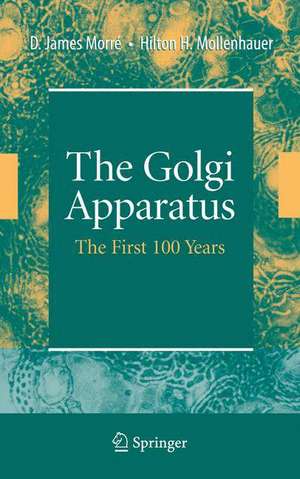The Golgi Apparatus: The First 100 Years
Autor James Morré, Hilton H. Mollenhaueren Limba Engleză Hardback – 17 dec 2008
| Toate formatele și edițiile | Preț | Express |
|---|---|---|
| Paperback (1) | 945.79 lei 6-8 săpt. | |
| Springer – 28 oct 2010 | 945.79 lei 6-8 săpt. | |
| Hardback (1) | 950.03 lei 6-8 săpt. | |
| Springer – 17 dec 2008 | 950.03 lei 6-8 săpt. |
Preț: 950.03 lei
Preț vechi: 1158.57 lei
-18% Nou
Puncte Express: 1425
Preț estimativ în valută:
181.81€ • 189.11$ • 150.10£
181.81€ • 189.11$ • 150.10£
Carte tipărită la comandă
Livrare economică 12-26 aprilie
Preluare comenzi: 021 569.72.76
Specificații
ISBN-13: 9780387743462
ISBN-10: 0387743464
Pagini: 307
Ilustrații: XIII, 307 p. 145 illus.
Dimensiuni: 155 x 235 x 20 mm
Greutate: 0.58 kg
Ediția:2009
Editura: Springer
Colecția Springer
Locul publicării:New York, NY, United States
ISBN-10: 0387743464
Pagini: 307
Ilustrații: XIII, 307 p. 145 illus.
Dimensiuni: 155 x 235 x 20 mm
Greutate: 0.58 kg
Ediția:2009
Editura: Springer
Colecția Springer
Locul publicării:New York, NY, United States
Public țintă
ResearchDescriere
The Golgi Apparatus: The First 100 Years traces the first 100 years of Golgi apparatus discovery from the first published accounts from Pavia, Italy in 1898 to the Centenary Celebration in Pavia, Italy in 1998 and into the decade beyond. It is not intended, however, to be a comprehensive survey but rather to present the perspectives of the authors to summarize their contributions over the past 50 years in parallel with the modern era of Golgi apparatus discovery initiated in 1954 and made possible by the advent of the electron microscope. Included are methods of cell fractionation and biochemical analysis leading up to the present where efforts focus heavily on molecular biology. Topics where the authors and their colleagues have made substantial and/or pioneering contributions are emphasized including Golgi apparatus morphology and structural organization and function (especially in plants), the existence and importance of cisternal tubules, development of methods of plant and animal Golgi apparatus isolation and subfractionation, biochemical analyses of highly purified plant and animal Golgi apparatus fractions in comparison to equally highly pu- fied reference fractions.
Cuprins
History of the Golgi Apparatus.- Morphology of the Golgi Apparatus (Architecture/Structure).- Isolation and Subfractionation.- Golgi Apparatus Tubules.- Golgi Apparatus and Membrane Biogenesis.- Golgi Apparatus Function in the Flow-Differentiation of Membranes.- Biochemistry of the Golgi Apparatus.- Golgi Apparatus Function in Secretion.- Golgi Apparatus Replication.- Cell Free Systems for Study of Golgi Apparatus Function.- Golgi Apparatus Function in Growth and Cell Enlargement.- The Golgi Apparatus and Cancer.- The Golgi Apparatus: A Look Ahead
Recenzii
From the reviews:
“The volume represents a dense personal account of the activities in a very vivid field of biomedical inquiry. … it can provide an important basis for future historical analyses.” (Ariane Dröscher, History and Philosophy of the Life Sciences, Vol. 34 (4), 2012)
“The volume represents a dense personal account of the activities in a very vivid field of biomedical inquiry. … it can provide an important basis for future historical analyses.” (Ariane Dröscher, History and Philosophy of the Life Sciences, Vol. 34 (4), 2012)
Textul de pe ultima copertă
The Golgi apparatus (GA) found as a ubiquitous component of all eukaryotic cells is typically comprised of stacks of 3 to 7 or more saccules called cisternae that consist of a lumen or central cavity surrounded by a membrane. At the peripheries of the saccules may be found perforations about 600 nM in diameter known as fenestrate. Such fenestrated margins are usually continuous with a system of vesicles and tubules. The individual stacks are organized into larger aggregate GA structures either side-by-side to form a complex ribbon with stacks interconnected by the peripheral tubules or in a dispersed arrangement with the stacks widely separated to appear almost as discrete units within the cytoplasm. The Golgi apparatus is often considered as the "distribution and shipping department" for the cell but also plays an equally important role in cell growth and membrane biogenesis. It modifies proteins and lipids (fats) to prepare them for export outside the cell or for delivery to the plasma membrane in support of membrane growth and replacement of membrane constituents lost due to turnover.
The Golgi Apparatus traces the first 100 years of GA discovery from the first published accounts from Pavia, Italy, in 1898 to the Centenary Celebration in Pavia, Italy, in 1998 to our most recent discoveries. It summarizes the past 50 years beginning with the modern era of GA discovery initiated in 1954 and made possible by the advent of the electron microscope, methods of cell fractionation and biochemical analysis, leading up to the present era where focus has been on molecular biology. Emphasized are organization and function, the existence and importance of cisternal tubules, development of methods of GA isolation and subfractionation, biochemical analyses of highly purified GA fractions and comparison to equally highly purified reference fractions and their use in cell free systems analysis of membrane trafficking, the concept of GA function as part of an integrated system of internal endomembranes (the endomembrane system), evidence for differentiation of membranes across the stacks of GA cisternae, and flux of membrane constituents along the polarity gradient defined by membrane differentiation all culminating in the membrane maturation or flow differentiation model of GA function. More recent contributions to GA in cell growth (enlargement) and to cancer are summarized in final chapters.
The Golgi Apparatus traces the first 100 years of GA discovery from the first published accounts from Pavia, Italy, in 1898 to the Centenary Celebration in Pavia, Italy, in 1998 to our most recent discoveries. It summarizes the past 50 years beginning with the modern era of GA discovery initiated in 1954 and made possible by the advent of the electron microscope, methods of cell fractionation and biochemical analysis, leading up to the present era where focus has been on molecular biology. Emphasized are organization and function, the existence and importance of cisternal tubules, development of methods of GA isolation and subfractionation, biochemical analyses of highly purified GA fractions and comparison to equally highly purified reference fractions and their use in cell free systems analysis of membrane trafficking, the concept of GA function as part of an integrated system of internal endomembranes (the endomembrane system), evidence for differentiation of membranes across the stacks of GA cisternae, and flux of membrane constituents along the polarity gradient defined by membrane differentiation all culminating in the membrane maturation or flow differentiation model of GA function. More recent contributions to GA in cell growth (enlargement) and to cancer are summarized in final chapters.
Caracteristici
Presents a historical review of Golgi Apparatus research
Offers a summarization of the the modern era of Golgi Apparatus discovery including cell fractionation and biochemical analysis
Focuses on molecular biology and discusses cell growth contributions
Includes supplementary material: sn.pub/extras
Offers a summarization of the the modern era of Golgi Apparatus discovery including cell fractionation and biochemical analysis
Focuses on molecular biology and discusses cell growth contributions
Includes supplementary material: sn.pub/extras








